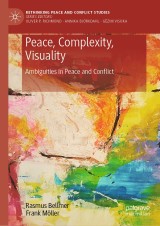Details

Peace, Complexity, Visuality
Ambiguities in Peace and ConflictRethinking Peace and Conflict Studies
|
139,09 € |
|
| Verlag: | Palgrave Macmillan |
| Format: | |
| Veröffentl.: | 12.08.2023 |
| ISBN/EAN: | 9783031382185 |
| Sprache: | englisch |
Dieses eBook enthält ein Wasserzeichen.
Beschreibungen
This book argues that we can capitalize on the tolerance of ambiguity-enhancing potentialities inherent in visual images – their non-coherence – and thus increase our capability of tolerating ambiguities. Studying international relations equals studying ambiguity. The international system is complex, and where there is complexity, there is also ambiguity. Crucially, in a world saturated not only with ambiguities but also with visual images, it is mandatory to think ambiguity and visuality together. The authors analyze the constructive and peaceful potentialities of ambiguities through an exploration of journalistic imagery in the context of post-war Bosnia and post-siege Sarajevo.<div><br><div>The book is a theoretically sophisticated, yet accessible, and politically relevant exercise in inter-disciplinary thinking, uniquely combining literature on complexity, ambiguity and visuality thus offering important readings for international relations, peace and conflict research, and security studies.<br></div></div>
Chapter 1: Introduction: Ambiguities in Local and Global Contexts.- Part I: Complexity and Ambiguity.- Chapter 2: Approaching Complexity in Peace and Conflict.- Chapter 3: Tolerance of Ambiguity.- Part II: New Photographies and Visual Ambiguities.- Chapter 4: The Crisis of Photojournalism and the Emergence of New Photographies.- Chapter 5: Visual Ambiguities: Controlling the Meaning of Images in a Digital and Interactive World.- Part III: <i>Bosnia: Uncertain Paths to Peace</i>.- Chapter 6: Introducing <i>Bosnia: Uncertain Paths to Peace</i>.- Chapter 7: Navigating <i>Bosnia: Uncertain Paths to Peace</i>.- Chapter 8: The Grids: Architectural Space and Panel-to-Panel Transitions.- Chapter 9: Interactivity and the Author-Audience Relationship.- Part IV: Leveraging Ambiguity for Peace.- Chapter 10: Embracing Difference: Learning from Bosnia?.- Chapter 11: Exploring the Surround, Appreciating Complexity.- Chapter 12: Active Looking: Images in Peace Mediation.- Chapter 13: Concluding Reflections: Tolerance of Ambiguity and the Ambiguity of Tolerance.
Rasmus Bellmer is based in Berlin and currently works for the Berghof Foundation. He holds a master’s degree in Peace, Mediation and Conflict Research. From 2020 to 2022, he worked as a project researcher in the research project <i>Peace Videography</i>, funded by Kone Foundation, and was affiliated with the Tampere Peace Research Institute, Tampere University, Finland. His research was published in journals such as International Political Sociology, Peacebuilding and Journal of Peace Education.<br><div><br></div><div>Frank Möller is a peace and conflict researcher residing in Tampere (Finland). He is affiliated with Tampere University as Docent in Peace and Conflict Research. From 2020 to 2022, he was in charge of the project <i>Peace Videography</i>, funded by Kone Foundation, and in 2023, he received a scholarship grant from the Gerda Henkel Foundation. Möller is the co-editor of <i>Art as a Political Witness</i> (2017) and the author of <i>Visual Peace: Images, Spectatorship and the Politics of Violence</i> (2013), <i>Peace Photography</i> (2019) and numerous journal articles and book chapters.<br></div>
This book argues that we can capitalize on the tolerance of ambiguity-enhancing potentialities inherent in visual images – their non-coherence – and thus increase our capability of tolerating ambiguities. Studying international relations equals studying ambiguity. The international system is complex, and where there is complexity, there is also ambiguity. Crucially, in a world saturated not only with ambiguities but also with visual images, it is mandatory to think ambiguity and visuality together. The authors analyze the constructive and peaceful potentialities of ambiguities through an exploration of journalistic imagery in the context of post-war Bosnia and post-siege Sarajevo.<div><br><div>The book is a theoretically sophisticated, yet accessible, and politically relevant exercise in inter-disciplinary thinking, uniquely combining literature on complexity, ambiguity and visuality thus offering important readings for international relations, peace and conflict research, and security studies.</div><div><br></div><div><b>Rasmus Bellmer</b> is based in Berlin and currently works for the Berghof Foundation. He holds a master’s degree in Peace, Mediation and Conflict Research. From 2020 to 2022, he worked as a project researcher in the research project <i>Peace Videography</i>, funded by Kone Foundation, and was affiliated with the Tampere Peace Research Institute, Tampere University, Finland. His research was published in journals such as International Political Sociology, Peacebuilding and Journal of Peace Education.<br><div><br></div><div><b>Frank Möller</b> is a peace and conflict researcher residing in Tampere (Finland). He is affiliated with Tampere University as Docent in Peace and Conflict Research. From 2020 to 2022, he was in charge of the project <i>Peace Videography</i>, funded by Kone Foundation, and in 2023, he received a scholarship grant from the Gerda Henkel Foundation. Möller is the co-editor of <i>Art as a Political Witness</i> (2017) and the author of <i>Visual Peace: Images, Spectatorship and the Politics of Violence</i> (2013), <i>Peace Photography</i> (2019) and numerous journal articles and book chapters.</div></div></div>
Helps develop new ways of thinking about and engaging in a world full of ambiguities Shows how to radicalize visual analysis in International Relations and develop new ways of perspective-taking Engages with the 'tolerance of ambiguity' enhancing capabilities of visuality and visual images
Diese Produkte könnten Sie auch interessieren:

Der erste arabisch-israelische Krieg und seine Folgen für die Palästinenser

von: Dean Sánchez Pedregoso

15,99 €

Chinas Soft Power Strategien und dessen politische Entwicklung anhand der der Olympischen Spiele 2008 und 2022

von: Alexander Kuhn

15,99 €















